Best EMF Meter for All (Professional Recommended)
This addition of the best EMF meter is another weigh-in from resident health and wellness expert, Laurie Cohen Peters:

To skip to the picks, use this index here:
I am very passionate about the topic of EMF hygiene. As someone who suffers from EMF sensitivity overload, I can tell you that understanding your daily exposure goes a long way to helping you feel your best.
My Story
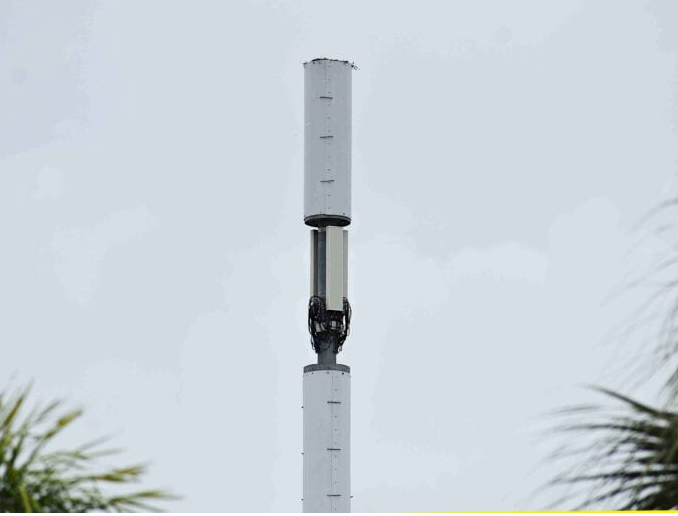
When I purchased my first home, it was an exciting accomplishment. Unfortunately, several years later, a large 4g cell tower appeared down the street seemingly overnight. It was roughly 400 feet from my door! Not long after that…my nightmare began.
I wasn’t sure back then, what a 4g tower looked like, nor even what it was, exactly. That said, the looming, cement, dome-like tower kept calling to me. What was it? I wondered as I drove up and down the hill and past it on the daily.

Not long after this thing popped up, I started having strange buzzing and pressurized sensations in my head, especially when I was falling asleep. One night it was so bad that I got down on the floor, my hands pressed into my ears and rocked back and forth in sheer agony. I thought I might need to go to the hospital.

The next day, I embarked on a lengthy research project to decipher my symptoms. This leads me to a group of “EMF” sufferers in Hawaii. Surprisingly, many of them described having the same symptoms as me. Thus began my journey down the EMF rabbit hole.
I wound up calling an expert to do a diagnostic of my home–sure he would tell me I had to sell. But, he didn’t. Instead, he showed me ways to lessen exposure. Some of his suggestions didn’t even involve my home, but rather, the removal of mercury fillings from my mouth. Other tasks were to get an EMF cage, a dirty electricity filter, and turn my router off at night. I opted not to get the EMF radiation blackout coverings, another option to block the many incoming signals from neighboring wifis.
I followed his instructions and my symptoms subsided.
This experience was life-changing. Consequently, I’m committed to helping others avoid the horrific outcome of EMF overload.

Please note, I use one of these meters myself. As well, I’ve seen the others in action when the expert evaluated my various homes throughout the years. However, I don’t make any affiliate coinage from them all.
Not all meters are created equally
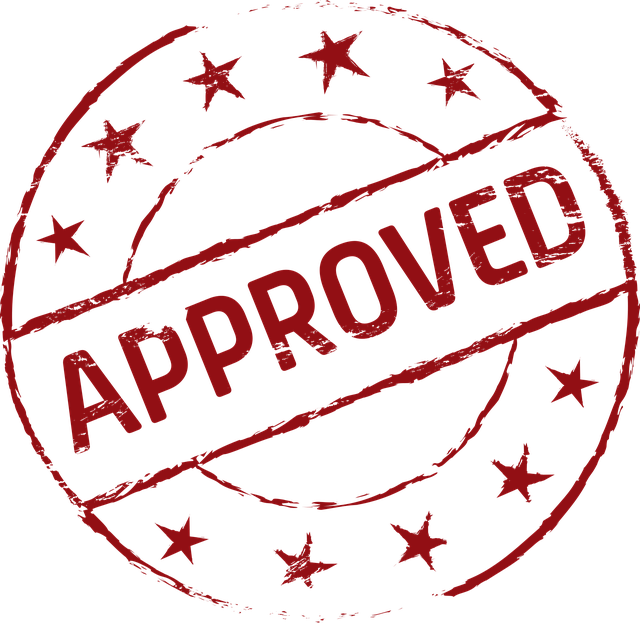
I don’t want to recommend any old meter. Hence, I’m confident that the ones listed below are of the best in the industry.
These products really helped me and I hope you find this article, and these products helpful too.
Here is to your optimum health!
What Is An EMF Meter?
An EMF (electromagnetic field) meter is a device used to measure the presence, strength, and direction of electromagnetic fields.
These fields are generated by a variety of sources, including electrical wiring, appliances, electronic devices, (computers, iPhones, tablets, smart appliances), and power lines.
What is an EMF meter used for?
EMF meters are commonly used in industrial and scientific environments. That said, as more is learned about the harmful aspects of EMFs, people are using them in their living spaces.

They may also be used to investigate potential sources of electromagnetic interference (EMI). This is especially helpful as a preventative. Doing so can help to assess potential health risks associated with prolonged exposure to high levels of electromagnetic radiation.
There are various types of EMF meters available on the market. They range from simple devices that measure the overall strength of the electromagnetic field to more sophisticated meters that can detect specific frequencies or types of electromagnetic radiation.
How did I arrive at this list?
EMF expert Oram Miller compiled a list of his top four best EMF meters that experts rely on when working with clients. He based his best meter picks off those generally recommended by the Building Biology Institute (BBI), though he explains that they’re not specifically endorsed by the IBE.

A Building Biology Professional tests for these four different kinds of EMFs:
- 60 Hz AC magnetic fields
- 60 Hz AC electric fields
- Radio frequencies
- Voltage spikes of harmonic frequencies of 60 Hz, also known as “dirty electricity”
*The Building Biology Evaluation Safe Exposure Guidelines started in 1987 in Germany. They are now in their seventh revision. Developed specifically for sleeping areas, they’re broken down into four levels of concern for all but “dirty electricity.”
What range of EMG exposure is right for you?
The four levels of concern are:
- No concern
- Slight concern
- Severe concern
- Extreme concern
Since these standards are quite stringent for the vast majority of the population, Oram suggests making sure that, at the least, you are not in the “severe concern” range. This stands also for most electrically hypersensitive (EHS) people.
Only the most highly EHS people need to try to achieve getting into the “No concern” level. This goal is generally not easy, and often near impossible to reach. That is unless you move way into the jungle!

“Slight concern” EMF level in the home is a realistic goal.
For the vast majority of people, getting somewhere into the “Slight concern” range is adequate. These levels are on par with the consensus for all field EMF exposure among non-industry EMF experts and researchers around the world. For instance, the “Slight concern” level for AC magnetic field exposure in the building biology profession is 0.1-1.0 milliGauss (mG), while the generally accepted safe magnetic field exposure level according to most experts is 1-2 mG.
To download and print out the building biology safe exposure guidelines, click here. Generally speaking, the safe levels we try to achieve are less than:
- 1.0 milliGauss (mG) for AC magnetic fields
- 100 milliVolts (mV) for AC electric fields
- 10 microWatts/meter squared (uW/m2) for radio frequencies while you sleep (I was also taught to try to get clients below 100 uW/m2 in the daytime)
- 25-50 Graham-Stetzer Units (GSU) for “dirty electricity”
In conclusion, while these are the ideals, it will be a challenge to achieve these safe levels in some circumstances. Conversely, it may be easy to achieve them in others.
Expensive meters aren’t always necessary
I listed the ones that are:
- easy to use
- affordable
- reliable readings on those EMFs considered potentially harmful
*More expensive meters don’t have the limitations that some of the meters listed here do. However, the meters mentioned below are consumer-friendly, easy to use, and reliable.
Let’s start with what, to me, are the most concerning EMFs in daily life…
Radiofrequency electromagnetic fields (RF EMFs)

RE EMFs are a type of electromagnetic radiation that includes radio waves, microwaves, and other types of waves with frequencies ranging from about 3 kilohertz (kHz) to 300 gigahertz (GHz). RF EMFs are used for a wide variety of purposes. Think radio and television broadcasting, mobile phone communication, and wireless networking.
RF EMFs are characterized by their frequency. And frequency determines their wavelength and the amount of energy they carry. Higher frequency RF EMFs, such as those used for mobile phone communication and wireless networking have shorter wavelengths and carry more energy than lower frequency RF EMFs than those used for radio and television broadcasting.
Exposure to RF EMFs can occur through the use of mobile phones, wireless devices, and other sources of RF radiation. There is ongoing research to investigate the potential health effects of RF EMFs, as some studies have suggested a possible link between long-term exposure to high levels of RF radiation and an increased risk of cancer and other health problems.
What is the top meter that experts and consumers use for detecting RF EMFs?
#1) Safe and Sound Classic 11 RF Meter for $169 (RF EMFs)
This is the one I use so I’m putting it up close and center!
Especially if you’re EMF sensitive and move around, stay in hotels often, or noticed new symptoms over time from being in the same neighborhood…Things change; towers go up, neighbors move in and out and new wifi addresses appear. This portable, user-friendly meter has saved me several times in making a mistake from where I choose to rent a vacation home to where I position my work desk. To purchase, click here.

*As I mentioned, I use this meter, and if I can figure it out, so can you!
New Features:
- More Lights
- Bigger Speaker – Louder Sounds
- More Sounds, Better Results
- Longer Battery Life
- 3rd Party Certified RF Detector with full frequency response from 200MHz – 8GHz
Other Features:
- No technical experience is required, easy to use and understand
- True response detection range: 200MHz – 8GHz
- Performance tested in 3rd party RF testing lab (report below)
- Sound signature analysis to assist with source identification
- Measurement ranges based on current Building Biology guidelines for sleeping areas
- Uses state-of-the-art measurement technology and is sensitive below 1 µW/m²
- Color-coded LEDs which identify exposure levels corresponding to Building Biology Guidelines
- Designed with Low EMF emissions
- Designed for the Electrically Hypersensitive person in mind
- Battery operated (3 x AAA) – 27 – 40 hour battery life
- Small, durable, and compact handheld design: 65mm X 90mm X 21mm (2.5″ X 3.5″ X 0.8″)
- Engineered in Canada – Manufactured in Canada and the USA
- 2 Year Warranty
Applications:
- Quickly determine RF present in your environment within 200 MHz and 8 GHz
- Some of the more common sources the meter can detect:
- Smart meter emissions
- Wireless routers (both 2.4 and 5 GHz channels)
- Cell towers
- Cell phone emissions
- Cordless home phones
- Bluetooth devices
- Baby monitors
- Airport radar
- Microwave oven leakage detection
- Video game consoles
Includes:
- Safe and Sound Classic II RF Detector
- Zippered Carrying Case
- User’s Guide
- 3 – AAA Alkaline Batteries
- 2 Year Warranty
And for testing 5g:
#2) Consider the upgrade: Safe and Sound Pro 11 RF Meter for $399
You can purchase it here

*I know, expensive, but worth it!
LCP Healthworks
Why do I love it Most? With all the talk about 5G, I love that this is not only 5G ready-low and mid bands, BUT —Third Party Tested!!
The Safe and Sound Pro II RF Meter is a professional RF meter designed to measure ambient radio frequency/microwave signals.
- Has a built-in antenna.
- This meter is a 3rd party-certified RF detector with an effective measurement frequency range of 200 MHz to 8 GHz and a true response detection range of 400 MHz to 7.2 GHz (+/- 6dB).
- Also includes a premium 4-line OLED Display for digital readings up to 3,180,000 µW/m² and down to 0.005 µW/m²
- Max Hold, Max Reset Button
- USB Power Jack for Continuous Monitoring
- Volume Control
- Headphone Jack
- Calibration Certificate and more!
AC magnetic field EMFS

AC magnetic field EMFs (Electromagnetic Fields) are a type of electromagnetic radiation that results from the flow of alternating current (AC) through a conductor. When AC flows through a wire, it creates a magnetic field that expands and contracts at the same frequency as the current.
These fields are characterized by their frequency (measured in Hertz, Hz) and their intensity (measured in Gauss or Tesla). AC magnetic fields are commonly generated by a variety of household and industrial devices. This includes power lines, electrical appliances, and electronic devices.
There is ongoing research on the potential health effects of exposure to AC magnetic field EMFs. Some studies have suggested a possible link between exposure to high levels of these fields and increased risk of certain health problems, including leukemia and other forms of cancer.
What are the top two choices that experts use for AC Magnetic Field EMFS?
#3) Magnii 3-Axis Backlight Gaussmeter $269 (AC Magnetic Field EMFs)
This meter is to detect AC magnetic field EMFs
To purchase, click here
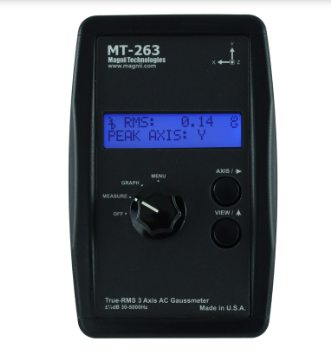
FEATURES OF THE MAGNII 3-AXIS BACKLIGHT GAUSSMETER
This EMF meter is suitable for general purpose measuring of extremely low frequency (ELF) magnetic field measurements.
- Made in the USA
- Selectable axis (3D, X, Y, Z) on all features, this meter is a real technological breakthrough.
- flat frequency response
- On-screen graphing
- Max hold
- Selectable units for milli-Gauss (mG) and micro-Tesla (uT).
- Updates at a fast 2.5 times per second and has a variable blue backlight light emitting diode (LED) display.
- The alkaline battery included typically lasts approximately 15 hours.
- Can be powered with the AC to 9V DC adapter (part number #174-9, sold separately) for prolonged use.
- One-year manufacturer’s warranty
- *This is the lowest price for a 3-axis digital Gauss Meter.
#4) Switchable Single Axis and 3-Axis Gaussmeter for $390.00 (AC Magnetic Field EMFs and Low Frequency (LF) EMFs)
To purchase, click here
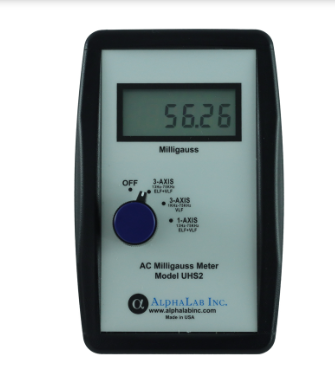
FEATURES OF THE SWITCHABLE SINGLE-AXIS AND 3-AXIS GAUSSMETER
*This digital unit can measure extremely low frequency (ELF)
- Made in the USA
- Compact and easy to use,
- Magnetic fields from 13 Hertz (Hz) to 1 kilohertz (kHz) and/or very low frequency (VLF)
- Magnetic fields from 1 to 75 kHz.
- This can be done in either single-axis mode to help identify the orientation of the field or 3-axis mode which makes routine measurements much faster and more reliable.
- One knob selects from 3 modes: 3-axis ELF+VLF, 3-axis VLF, 1-axis ELF+VLF.
- Ranges from 0.01 milli-Gauss (mG) to 1999 mG.
- One-year manufacturer’s warranty
AC Electric Field EMFs

AC electric fields refer to alternating current electric fields, which are oscillating fields that periodically reverse direction. An alternating current flows through a conductor, such as a wire and this generates an AC electric field.
Frequency is the number of cycles per second, are measured in hertz (Hz). AC electric fields are characterized by this number. In North America, the standard frequency for AC electric electric and magnetic fields is 60 Hz, while in Europe and most other parts of the world, the standard frequency is 50 Hz.
AC electric fields are used for a wide range of applications, including power transmission, lighting, and electric motors. They’re also used in household appliances, such as refrigerators, air conditioners, and washing machines. However, high levels of AC electric fields can be harmful to human health. Subsequently, exposure to strong fields over a long period of time has been associated with an increased risk of cancer and other health problems.
What do experts use for AC Electric Field EMFs?
#5) Body Voltage Meter for $89 (AC Electric Field EMFs)
To purchase, click here
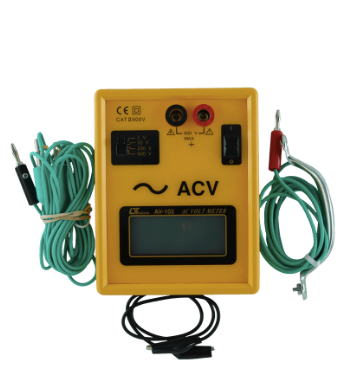
Features of the Body Voltage Meter
An external field will induce an electric field within our bodies. In this sense, our bodies act as antennas picking up fields from electric blankets, alarm clocks cell phones, power lines, and just about everything connected to a source of electric power.
Delicate biological cellular processes (like brain function and heart muscle contraction) operate on the scale of microVolts to milliVolts. the human Body, Voltage can exceed several Volts in some cases.
The Body Voltage Meter quickly and easily reports this induced AC body voltage. Simply hold the sensor handle. Notice how your body voltage varies as you move about the room, as you change position (standing vs lying down, for example) and it also depends on what you are wearing.
The Body Voltage Meter is a great way to test the effectiveness of your static discharge (ESD) devices. It’s also used to measure the AC voltage build up on static producing surfaces. Large digital readout is easy to see and sensitive down to 1 mV.
This type of EMF meter will help you detect irritating voltage sources which may not otherwise be obvious.
- Comes complete
- Includes 3 – prong plug adapter for indoor use
- Uses 1 9V battery (not included)
- Calibrated for 40-500 Hz.
ElectroMagnetic Interference (EMI), also known as “dirty electricity.”

Dirty electricity, also known as electrical pollution, refers to electrical noise or electromagnetic interference (EMI) that contaminates the electrical power supply.
This EMI can distort the quality of the electricity flowing through electrical wires, leading to a variety of problems such as power surges, voltage fluctuations, and harmonic distortions.
Dirty electricity is caused by a number of factors. This includes electrical devices that generate high-frequency harmonics, power lines and transformers, and electronic equipment that produces interference. Some common sources of dirty electricity include computers, televisions, compact fluorescent lights, and solar panels. Yep, solar panels.
Some people have reported symptoms such as headaches, fatigue, and insomnia that they attribute to exposure to dirty electricity.
What is my top choice for an EMI or “dirty electricity” meter?
#6) Stetzer Meter for $150 (EMI or “dirty electricity”)
To purchase, click here

A special meter has been developed which can be plugged into an electrical outlet to determine the levels of EMF high-frequency pollution in your home or office both before and after using the HF EMPOR.
The readout of the meter gives an indication of how much high-frequency noise is in the wiring at the outlet where the meter is located. The higher the readout, the more high-frequency pollution. The readout is not calibrated but is very useful for making relative (comparison) measurements.
Ideally, the readout should be as low as possible. It is generally agreed that readings should be below 50.
- Extremely easy to use and reliable.
- Designed to measure only the high-frequency noise which may exist in your electrical wiring.
- Contains special filters which remove the normal 50/60 Hz signal for the readout.
- Very easy to use. Simply plug the meter into an electric outlet.
- The meter works equally well on standard outlets (2-prong, or 3-prong), and GFI outlets.
- Can be used with surge suppressors, power strips, or extension cords.
- The meter is reusable.
- Can be used on 50/60 Hz, 110-230 V systems.
Covers 10 kHz to 100 kHz. Has a standard 2-prong North American plug, so you will need an adapter to use it outside of N. America.








